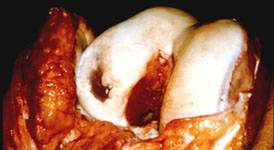Recently a News paper carried a report on Autologous Chondrocyte Implantation in India. Chondroctyes form the substance of articular cartilage in joints. Articular cartilage is the shiny lining or shock absorber of joints. Articular chondrocyte implantation refers to the surgical implantation of articular cartilage forming cells in an area of localized cartilage loss. This procedure is gaining ground amongst young athletes with cartilage injuries.
The properties of articular cartilage ensure smooth painless movements.
This article will try to bring out the facts of cartilage defects and the latest advances in treatment in India.
World arthritis day is observed on 12th October each year.
Traumatic cartilage defects of the knee are common in athletes. They arise in conjunction with ligament and meniscal injuries.
Full thickness articluar cartilage defects have a poor capacity for self repair. If large defects are left untreated, they have the potential to progress to osteo-arthritis. Pain and disability are the resultant outcome and may need a Joint replacement.
Advances in cartilage surgery have rendered these lesions/defects amenable to biological treatment. Traditional surgical methods of treatment are Micro fracture, abrasion chondrplasty, mosaicplasty
These regenerative methods fall under two headings, repair or restoration. In a reparative procedure, an attempt is made to repair the damaged area with a substitute tissue called fibro cartilage with a surgical procedure.
In a restorative or regenerative method, articular cartilage is itself regenerated to replace the defect.
This method is available in India. It is called Autologous cartilage cell implantation or ACI.
Autologous cartilage cell implantation has good short to medium term results. Started by Brittberg et al from Sweden in 1987 and the first clinical results were published in 1994.
This group have shown good to excellent results in about 100 patients with two to nine years follow up.
Results from another group Genzyme showed that 70 % patients improved.
It is now possible to perform Autologous cartilage cell implantation in India at affordable costs.
The procedures has three steps. In the first step, a biopsy of cartilage is taken from a healthy portion. This is sent to a lab for cultures. Several million cartilage cells are regenerated by culture.
This tissue is re implanted in the defective area of cartilage by an open method. Following this procedures, rehabilitation is commenced.
Articular cartilage is regenerated and can be confirmed by MRI and a second look arthroscopy.

Articular cartilage lesion in knee
I use the fourth generation cartilage regeneration technique called ” Cell Gel technique” whereas earlier reports were based on 2nd or 3 rd generation techniques. In these techniques, the raw area of cartilage loss had to be covered by a periosteal graft to contain the cells. The disadvantages were that the graft would fall off.
In the method employed by us, the cartilage cells are delivered in a patented Cell Gell mixture. These adhere to the raw area immediately and no covering is required.
See this Slide show on Fourth generation cartilage generation technique. http://www.slideshare.net/akvenkat/knee-cartilage-surgery-in-india



How do you handle opposing lesions? Do you do two surgeries so that the hydrogels do not adhere and pull each other out?
I attempt to resurface the femur. Results of cartilage replacement of the tibia are not well known.
What is the max size of cartilage defect that can be covered in patellofemoral joint?
About 2-3 cm